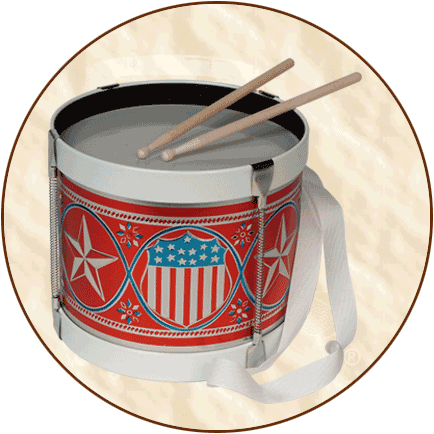.
Continued from product description on
Folk Instruments' Page Three...
Historical
Background: Drums are among the most ancient and widespread
of all musical instruments. They are found in all the primitive
cultures known to man. A Sumerian vase from the third millennium
B.C. depicts a man-sized drum. The oldest surviving drums are
Egyptian and date back to 1800 B.C. In literature, Chinese poems
from around 1135 B.C. mention the playing of drums.
Drums migrated from China to Europe via Greece, where use
of the "tympanon" was restricted to the Cybele and
Dionysus cults. The earliest evidence of playing a drum in Europe
is a 12th-century miniature depicting a juggler dressed as a
bear and striking his hands on a barrel drum hung around his
neck. A 13th-century Spanish miniature shows a performer playing
an hourglass drum. It is thought that such forms were probably
imported to Europe from China during the Crusades.
Before 1300 A.D., Arabians developed small kettledrums that
were used in pairs called the "nagarah" (or "naqqarah").
Such drums were called "nacaires" in France, "naccheroni"
in Italy, and "nakers" in England. The cylindrical
drum appeared about the same time under the name "tabor."
Other names for tabor are "tambour" (French), and "tamburo"
(Italian).
According to manuscripts and paintings, it was King Henry
VII who brought what is called the "rope tension drum"
to England in the late 15th century. If one wished to own such
a drum, he had to first get a license from the king. And even
if one was lucky enough to obtain a royal license, he could only
play "approved" military beatings, such as the "English
March."
Today's marching and orchestral drums are descendants of rope
tension drums. The construction of a rope tension drum consists
of a shell (body), two calfskin drumheads, two wooden hoops,
leather ears, and a cotton rope. Tension on the head of the drum
is achieved by lacing several yards of rope through the ears
which are attached to the hoops (rims). When the rope is tightened,
the ears and hoops are pulled to the center of the shell.
The rope tension drum is also known as a "side drum."
This is because the player (drummer) carries the drum to his
side to allow for walking and playing at the same time. The drum
is attached to a sling which is slung over the player's shoulder.
The traditional grip of the drumsticks came about due to the
angle of the drum head when carried in this manner. (This is
still the preferred grip used by today's drum corps.)
Another name given to the rope tension drum is "field
drum." The word "field" comes from the use of
the drum on fields of battle. Field drums were used to help soldiers
keep cadence with beats. They are thought to also have been used
to communicate commands to the troops with signals. There is
some question as to the validity of this, however. Some suggest
it would have been unwise to signal troops in any manner that
would also tell the enemy what to expect. Nevertheless, drum
calls were used to relay commands of officers by the types of
beats played.
From the time of King Henry VII until the late-19th century,
rope tension drums have been an important part of military life
and logistics. In Europe, drums have since been closely associated
with royal ceremonies. Elsewhere, drums have played a prominent
role in military and political ceremonies.
Present-day use of the terms "drum" and "tabor"
refer to how a drum is played and accompanied by a pipe (fife).
The difference between "fife and drum" and "pipe
and tabor" is the number of players. A pipe-and-tabor player
is a single person playing both instruments. A fife and drum
ensemble is when two or more performers play one of these instruments.
Fun
Fact: Rope tension drums used free-floating technology
centuries before today's popular free-floater snare drums.
For more information about the historical use of drums, please
see our Plastic Fife in C (5104)
and Brass Fife in B Flat (5201)
for their historical backgrounds.













